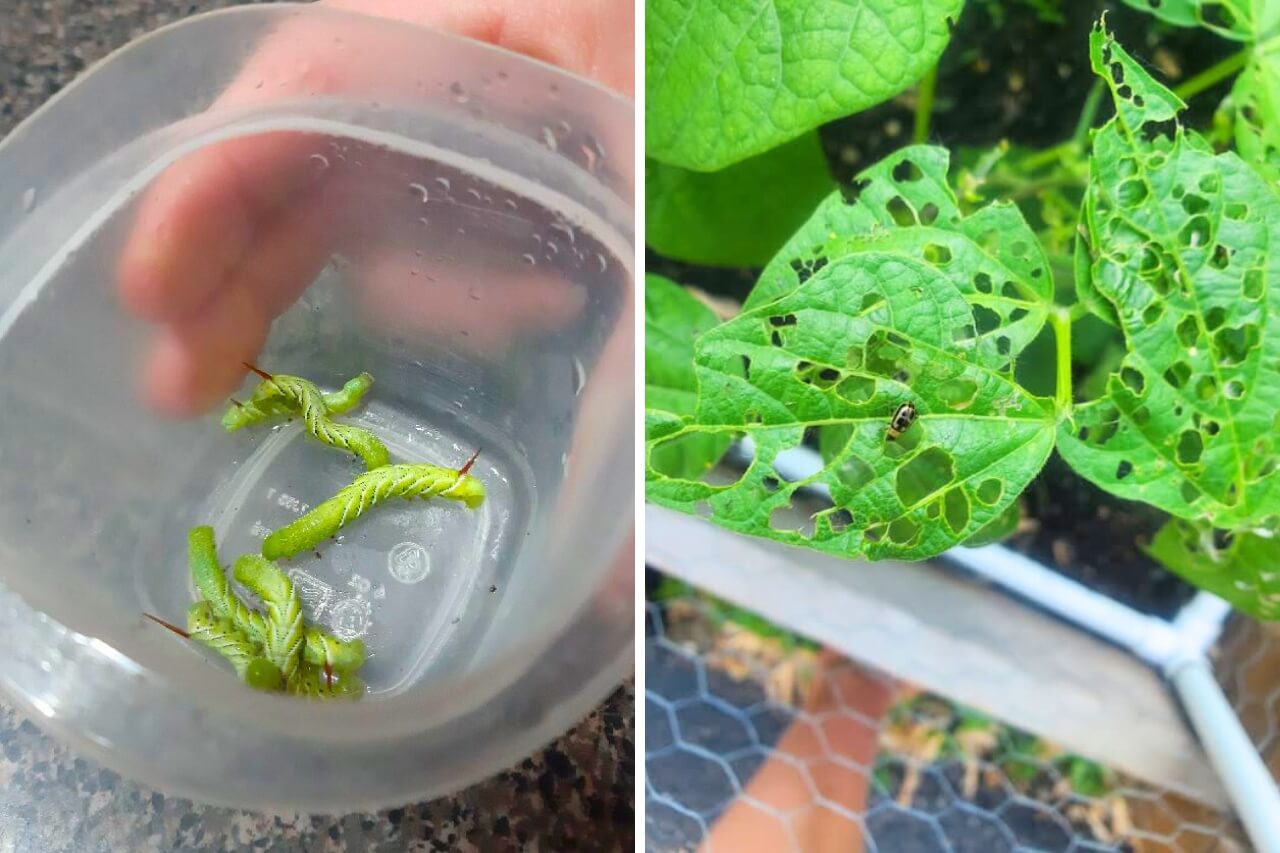There is no way to escape from it; where there is a garden, there are pests.
Sooner or later, you’ll have to deal with them, and obviously, it’s good to know them in order to know how to get rid of them.
In this guide, I’ll introduce the most common ones that beginner and intermediate gardeners are likely to encounter.
For each pest, you’ll learn how to identify it, what kind of damage it causes, and how to manage it using natural methods. I’ll also mention safe chemical options only for those pests that are especially stubborn (with tips to use them carefully).
Aphids
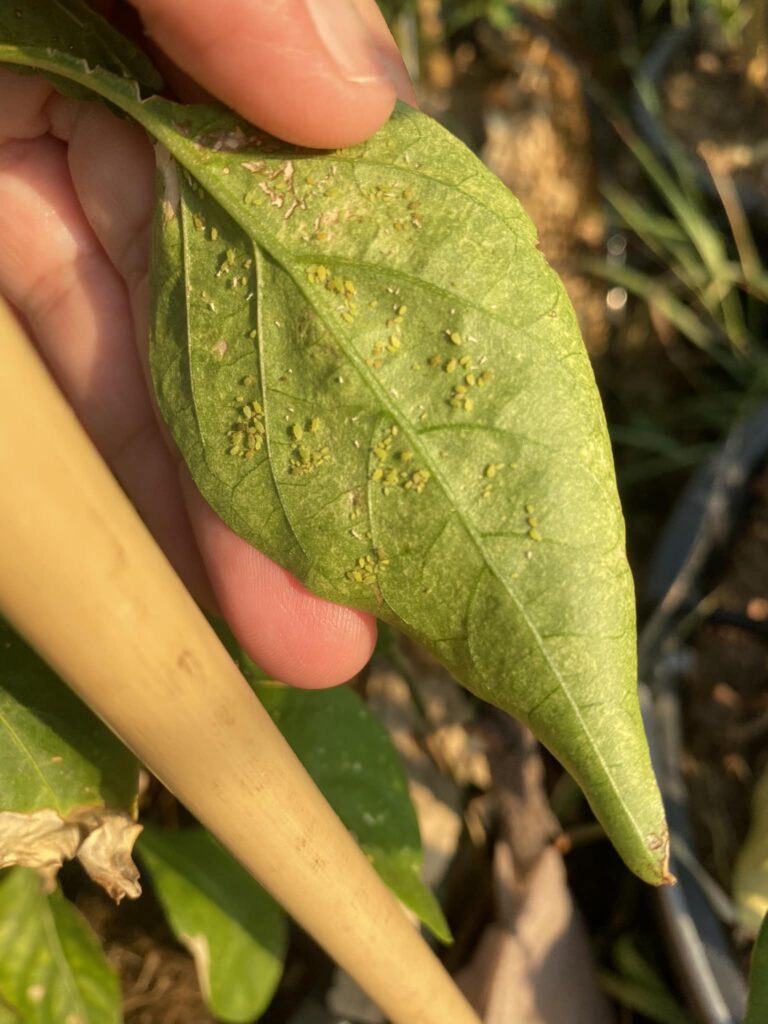
Aphids are tiny ( about 1 to 3 mm), soft-bodied insects that can be green, black, yellow, or other colors.
They often cluster on new growth or the undersides of leaves. You might spot them by the sticky “honeydew” residue they leave behind on foliage.
This sugary honeydew can lead to black sooty mold on leaves. Ants on your plants can also be a clue, since ants farm aphids for that honeydew.
Aphids use their piercing-sucking mouthparts to suck sap from plants, causing curled, yellowing, or distorted leaves.
Heavy infestations can stunt plant growth, they can transmit plant viruses, and the honeydew they produce not only encourages mold but can also attract other pests.
Fortunately, it is quite easy to get rid of it. Prepare a spray with 1 tablespoon of Castile soap (or a mild dish soap) and 1 quart of water.
Shake lightly before each use, not too hard to avoid too much foam, and spray directly on aphids and on the underside of leaves in the morning or in the evening (avoid the hottest part of the day).
Slugs and Snails
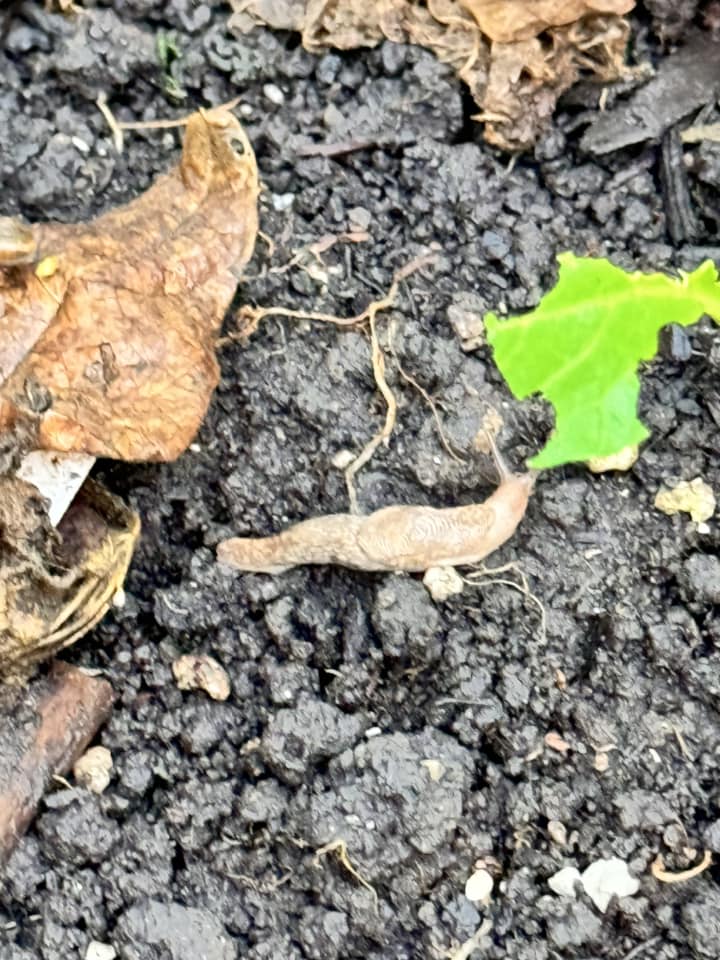
We all know the slugs and snails, so I don’t think we need any introduction. Just to be clear, slugs are soft, slimy, and legless with elongated bodies, while snails carry that familiar spiral shell.
They often hide during the day in cool, damp spots (under boards, rocks, dense groundcover) and come out at night or early morning to feed. A telltale sign of slugs/snails is the silvery slime trail they leave on soil or sidewalks, so keep your eyes open.
You’ll also notice that they chew irregularly shaped holes in plant leaves and flowers. Because of their rasping mouthparts, the holes have ragged edges (unlike the clean cuts of some caterpillars).
One of the best things you can do is to check your plants after dark or early in the morning. Grab a flashlight and pick slugs and snails off plants by hand (obviously I wear gloves because I don’t like to touch those squishy things).
To deter their presence, keep your garden tidy. Slugs thrive in moist, shady areas under leaf litter, mulch, or weeds. Clearing decaying debris and using drip irrigation (instead of overhead sprinklers) helps reduce the humid habitat that slugs love.
You can also use some barriers like copper tape around pots or beds, or also abrasive materials like crushed eggshells or diatomaceous earth around plant bases.
Japanese Beetles
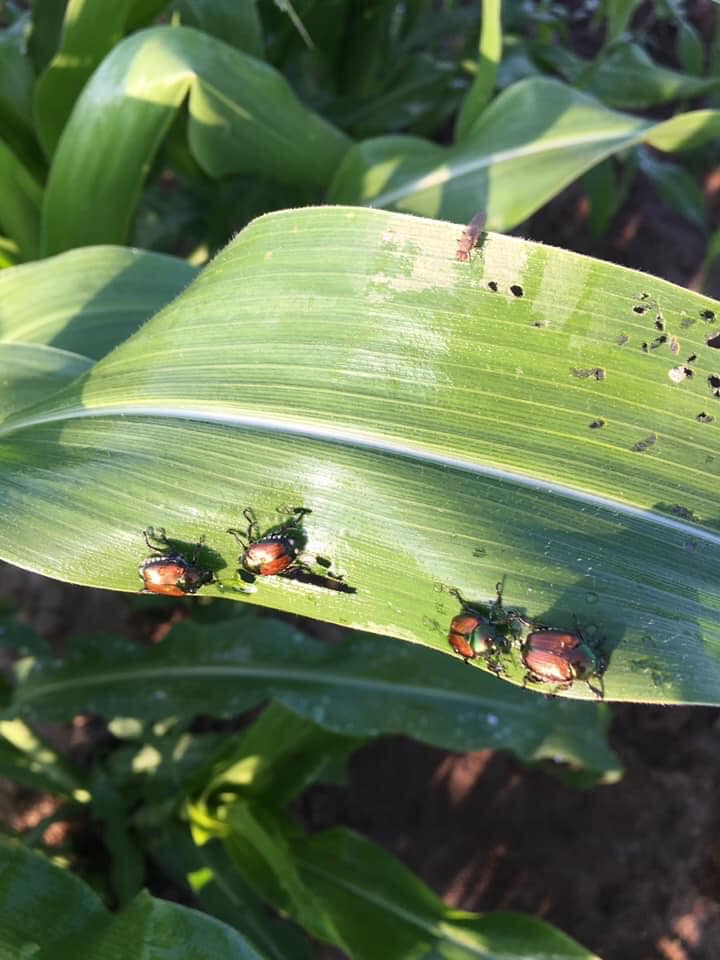
Japanese beetles are quite eye-catching. Adults are about 1/2 inch long with shiny, metallic green bodies and copper-colored wing covers.
They often have small white tufts of hair along their sides and you’ll usually see them in midsummer, sometimes clustered on flowers or leaves. If disturbed, they may drop to the ground and try to burrow
Adult Japanese beetles feed on the foliage, flowers, and fruits of over 300 plant species, which is why they’re so common, and I’ve often seen them on roses, grapes, beans, raspberries, and linden trees.
A classic sign of Japanese beetle damage is “skeletonized” leaves, they chew the tissue between leaf veins, leaving a lace-like skeleton of the leaf. Flowers can be devoured entirely, and ripe fruit will be gnawed and rotten on the edges.
It sounds simplistic, but hand-picking is very effective for Japanese beetles. In the cool early morning or evening, the beetles are sluggish and easier to catch.
A good method is to shake branches or pluck the beetles and drop them into a bucket, and since these beetles often congregate, removing a bunch at once can really diminish the attraction for more beetles to come.
That’s why I don’t recommend using traps. If they catch a few beetles, they usually end up attracting even more to your yard than they actually trap.
Whiteflies

Whiteflies may be small, but their effects on plants can be big. Don’t be fooled by the name because these pests are not true flies at all, but tiny white-winged insects related to aphids and scales.
They often lurk on the underside of leaves. When you brush against an infested plant, a cloud of tiny white moth-like bugs will flutter up, that’s the most obvious giveaway.
Gardeners in warm regions or greenhouse growers commonly encounter whiteflies on vegetables (like tomatoes, squash, peppers) and ornamentals (like hibiscus or fuchsia). They’re also frequent pests of houseplants.
Like aphids, whiteflies have needle-like mouthparts to suck sap from leaves. Early on, you might notice leaves getting pale or mottled with yellow spots (from where the juices have been sucked out).
As feeding continues, leaves may wilt, turn yellow, and eventually drop off if the infestation is heavy.
To get rid of them, use the same spray we saw for aphids, mixing soap and water. The soap breaks down their protective coating, causing them to dehydrate and die
Another thing that is becoming very popular in recent years is the yellow sticky traps. You’ve probably seen them somewhere, and the idea behind them is quite simple.
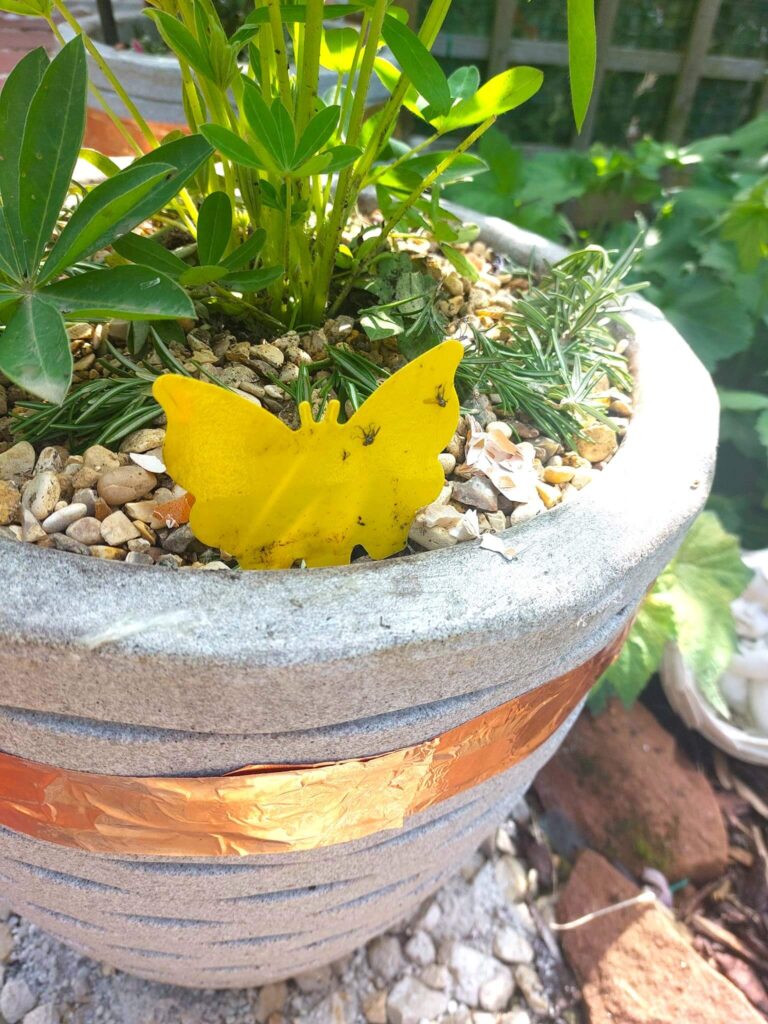
Since whiteflies are attracted to the color yellow, hanging yellow sticky cards near infested plants can capture the adults and reduce the breeding population.
PRO TIP: The sticky traps may catch high beneficial insects such as bees, so don’t use them as a preventive method, but place them only near infested plants.
Tomato Hornworms
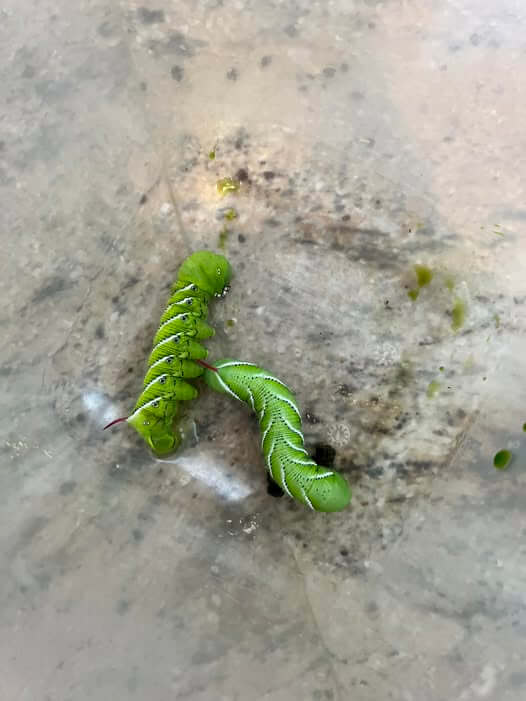
The tomato hornworm is the huge green caterpillar that gives many gardeners a start when they finally spot it (like it happens to me every time I see one).
These guys can reach 3 to 4 inches long and as thick as a finger. They are green with white diagonal stripes and a signature horn-like spike on their rear end (don’t worry, it doesn’t sting).
Hornworms are the larvae of hawk moths (also called sphinx or hummingbird moths) and they often blend in amazingly well with foliage.
You might notice dark green droppings (frass) on lower leaves or the ground, a clue that something sizable is eating your plant.
The name already says what his favorite plants are, but they’ll also eat peppers, eggplants, and potatoes.
Thankfully, hornworms are big enough to spot (once you train your eye) and easy to remove by hand.
Inspect your tomato plants at least a few times a week, especially if you see chewed leaves. Pick off any hornworms you find and relocate them far away (if you have chickens they love them).
Another thing I always recommend is garden diversity, A garden rich in flowers and habitat will invite many hornworm enemies. Birds, spiders, and insects like ladybugs and green lacewings will eat hornworm eggs or young larvae.
My nonna always told me to plant dill, fennel, or Queen Anne’s lace near tomatoes because they can attract parasitic wasps that keep hornworms in check.
In addition, always keep tomato plants under control and well cared for. Take a look at my guide on how to prune tomatoes for maximum yield and plant health

